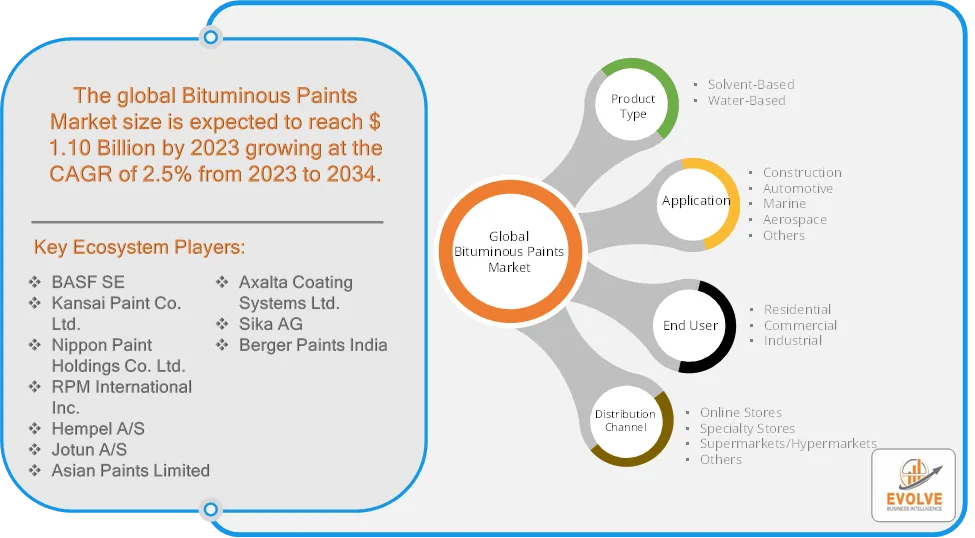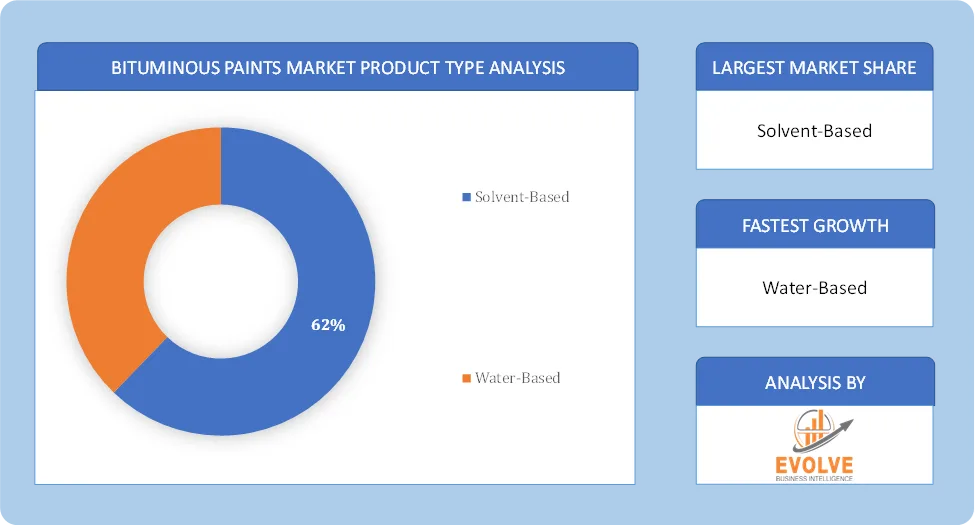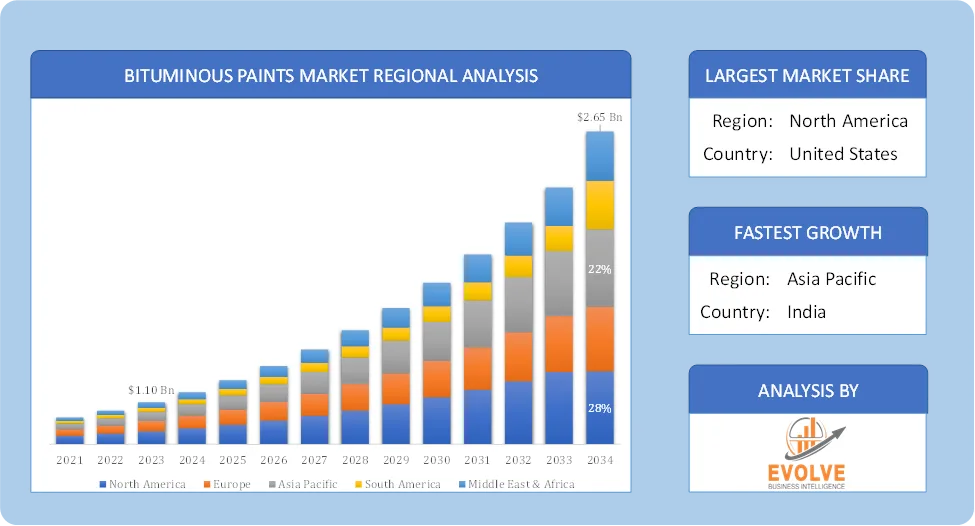Bituminous Paints Market Analysis and Global Forecast 2024-2034
$ 1,390.00 – $ 5,520.00Price range: $ 1,390.00 through $ 5,520.00
Bituminous Paints Market Research Report: Information By Product Type (Solvent-Based, Water-Based), Application (Construction, Automotive, Marine, Aerospace, and Others), End-User (Residential, Commercial, Industrial), Distribution Channel (Online Stores, Specialty Stores, Supermarkets/Hypermarkets, and Others), and by Region — Forecast till 2034
Page: 165
Bituminous Paints Market Overview
The Bituminous Paints Market size accounted for USD 1.10 Billion in 2023 and is estimated to account for 1.25 Billion in 2024. The Market is expected to reah USD 2.65 Billion by 2034 growing at a compound annual growth rate (CAGR) of 2.5% from 2024 to 2034. Bituminous paints, also known as asphalt or coal tar coatings, are primarily composed of bitumen and offer excellent waterproofing and corrosion resistance properties. These paints are widely used across various industries, including construction, automotive, and marine, due to their durability and resilience against weather conditions and environmental factors.
The Bituminous Paints Market is expected to grow steadily due to increasing construction and infrastructure development. However, companies need to focus on sustainable solutions to comply with environmental regulations while maintaining performance and cost-effectiveness.
Global Bituminous Paints Market Synopsis
 Bituminous Paints Market Dynamics
Bituminous Paints Market Dynamics
The major factors that have impacted the growth of Bituminous Paints Market are as follows:
Drivers:
Ø Expanding Marine and Automotive Sectors
The marine industry requires bituminous coatings for corrosion protection of ships, docks, and offshore structures. In the automotive sector, bituminous paints are used for undercoating vehicles to prevent rust and improve durability. The development of low-VOC, water-based bituminous paints is expanding market opportunities amid increasing environmental regulations. Growing demand for sustainable coatings is encouraging manufacturers to invest in research and development. Countries like China, India, and Brazil are witnessing rapid industrial growth, leading to increased demand for protective coatings in multiple sectors.
Restraint:
- High Fluctuating Raw Material Prices
The primary raw material for bituminous paints is petroleum-based bitumen, which is subject to price volatility due to fluctuations in crude oil prices. High raw material costs can impact profit margins and production costs for manufacturers. The use of bituminous coatings involves exposure to hazardous fumes and chemicals, raising occupational health concerns for workers and the need for protective measures and proper ventilation during application increases handling complexity and costs.
Opportunity:
⮚ Growing Demand for Eco-Friendly and Water-Based Bituminous Paints
With increasing environmental regulations on VOC emissions, there is a rising demand for water-based and low-VOC bituminous paints. Manufacturers investing in sustainable formulations can capture a larger market share, especially in Europe and North America. Rapid urbanization and infrastructure expansion in countries like India, China, Brazil, and Southeast Asian nations create high demand for bituminous coatings in construction and waterproofing applications. Automotive manufacturers are using bituminous paints for undercoating to enhance rust protection and vehicle longevity and growth in electric vehicle (EV) production could further drive demand for protective coatings.
Bituminous Paints Market Segment Overview
Based on Product Type, the market is segmented based on Solvent-Based, Water-Based. Solvent-Based segment dominant the market. Solvent-based bituminous paints have been traditionally preferred due to their superior adhesion properties and durability. These paints are extensively used in applications requiring robust protection against harsh environmental conditions, such as in marine and industrial settings.
By Application
Based on Application, the market segment has been divided Construction, Automotive, Marine, Aerospace, and Others. The construction segment dominant the market, driven by the extensive use of bituminous paints for waterproofing and protective coatings in residential, commercial, and industrial buildings. The demand for durable coatings that can withstand harsh environmental conditions is a key factor driving the growth of bituminous paints in the construction industry.
By End User
Based on End User, the market segment has been divided into Residential, Commercial and Industrial. The residential segment dominant the market, driven by the demand for waterproofing and protective coatings in homes and residential buildings. As urbanization continues to accelerate, particularly in developing countries, the need for durable and weather-resistant coatings in residential construction is expected to drive market growth.
By Distribution Channel
Based on Distribution Channel, the market segment has been divided into Online Stores, Specialty Stores, Supermarkets/Hypermarkets, and Others. Online stores segment dominant the market, Online stores are gaining popularity as a distribution channel, driven by the convenience and accessibility they offer to consumers. The growing trend of online shopping, particularly in the wake of the COVID-19 pandemic, is expected to drive the growth of online stores as a distribution channel for bituminous paints.
Global Bituminous Paints Market Regional Analysis
Based on region, the global Bituminous Paints Market has been divided into North America, Europe, Asia-Pacific, the Middle East & Africa, and Latin America. North America is projected to dominate the use of the Bituminous Paints Market followed by the Asia-Pacific and Europe regions.
 North America Bituminous Paints Market
North America Bituminous Paints Market
North America holds a dominant position in the Bituminous Paints Market. North America region has extensive infrastructure development and renovation projects, particularly in the United States. Increasing focus on eco-friendly formulations and compliance with environmental regulations like the EPA’s emission standards. This has spurred innovations in sustainable bituminous paints with lower VOC content and also Canada’s emphasis on sustainable construction practices. Increased government spending on infrastructure development.
Asia-Pacific Bituminous Paints Market
The Asia-Pacific region has indeed emerged as the fastest-growing market for the Bituminous Paints Market industry. Rapid urbanization, industrialization, and extensive infrastructure development, particularly in China and India. Significant growth in the aviation industry also complements market growth. Japan’s focus on earthquake-resistant construction, utilizing bituminous coatings to enhance structural integrity and Rising demand for cost-effective waterproofing solutions in residential and commercial buildings.
Competitive Landscape
The global Bituminous Paints Market is highly competitive, with numerous players offering a wide range of software solutions. The competitive landscape is characterized by the presence of established companies, as well as emerging startups and niche players. To increase their market position and attract a wide consumer base, the businesses are employing various strategies, such as product launches, and strategic alliances.
Prominent Players:
- BASF SE
- Kansai Paint Co. Ltd.
- Nippon Paint Holdings Co. Ltd.
- RPM International Inc.
- Hempel A/S
- Jotun A/S
- Asian Paints Limited
- Axalta Coating Systems Ltd.
- Sika AG
- Berger Paints India Limited.
Key Development
In November 2024, Sherwin-Williams Company unveiled a new range of bituminous paints designed for infrastructure projects, incorporating eco-friendly formulations to meet U.S. regulatory standards.
In October 2024-BASF SE announced the construction of a 200 million Euros production facility for bituminous coatings in Germany, aimed at enhancing efficiency and sustainability in manufacturing.
Scope of the Report
Global Bituminous Paints Market, by Product Type
- Solvent-Based
- Water-Based
Global Bituminous Paints Market, by Application
- Construction
- Automotive
- Marine
- Aerospace
- Others
Global Bituminous Paints Market, by End User
- Residential
- Commercial
- Industrial
Global Bituminous Paints Market, by Distribution Channel
- Online Stores
- Specialty Stores
- Supermarkets/Hypermarkets
- Others
Global Bituminous Paints Market, by Region
- North America
- US
- Canada
- Mexico
- Europe
- UK
- Germany
- France
- Italy
- Spain
- Benelux
- Nordic
- Rest of Europe
- Asia Pacific
- China
- Japan
- South Korea
- Indonesia
- Austalia
- Malaysia
- India
- Rest of Asia Pacific
- South America
- Brazil
- Argentina
- Rest of South America
- Middle East & Africa
- Saudi Arabia
- UAE
- Egypt
- South Africa
- Rest of Middle East & Africa
| Parameters | Indicators |
|---|---|
| Market Size | 2034: USD 2.65 Billion |
| CAGR (2024-2034) | 2.5% |
| Base year | 2022 |
| Forecast Period | 2024-2034 |
| Historical Data | 2021 (2017 to 2020 On Demand) |
| Report Coverage | Revenue Forecast, Competitive Landscape, Growth Factors, and Trends |
| Key Segmentations | Product Type, Application, End User and Distribution Channel |
| Geographies Covered | North America, Europe, Asia-Pacific, South America, Middle East, Africa |
| Key Vendors | BASF SE, Kansai Paint Co. Ltd., Nippon Paint Holdings Co. Ltd., RPM International Inc., Hempel A/S, Jotun A/S, Asian Paints Limited, Axalta Coating Systems Ltd., Sika AG and Berger Paints India Limited. |
| Key Market Opportunities | · Growing Demand for Eco-Friendly and Water-Based Bituminous Paints |
| Key Market Drivers | · Expanding Marine and Automotive Sectors
· Advancements in Eco-Friendly Formulations |
REPORT CONTENT BRIEF:
- High-level analysis of the current and future Bituminous Paints Market trends and opportunities
- Detailed analysis of current market drivers, restraining factors, and opportunities in the future
- Bituminous Paints Market historical market size for the year 2021, and forecast from 2023 to 2033
- Bituminous Paints Market share analysis at each product level
- Competitor analysis with detailed insight into its product segment, Government & Defense strength, and strategies adopted.
- Identifies key strategies adopted including product launches and developments, mergers and acquisitions, joint ventures, collaborations, and partnerships as well as funding taken and investment done, among others.
- To identify and understand the various factors involved in the global Bituminous Paints Market affected by the pandemic
- To provide a detailed insight into the major companies operating in the market. The profiling will include the Government & Defense health of the company’s past 2-3 years with segmental and regional revenue breakup, product offering, recent developments, SWOT analysis, and key strategies.
Frequently Asked Questions (FAQ)
What is the study period of this market?
The study period of the global Bituminous Paints Market is 2021- 2033
What is the growth rate of the global Bituminous Paints Market?
The global Bituminous Paints Market is growing at a CAGR of 2.5% over the next 10 years
Which region has the highest growth rate in the market of Bituminous Paints Market?
Asia Pacific is expected to register the highest CAGR during 2024-2034
Which region has the largest share of the global Bituminous Paints Market?
North America holds the largest share in 2022
Who are the key players in the global Bituminous Paints Market?
BASF SE, Kansai Paint Co. Ltd., Nippon Paint Holdings Co. Ltd., RPM International Inc., Hempel A/S, Jotun A/S, Asian Paints Limited, Axalta Coating Systems Ltd., Sika AG and Berger Paints India Limited. are the major companies operating in the market.
Do you offer Post Sale Support?
Yes, we offer 16 hours of analyst support to solve the queries
Do you sell particular sections of a report?
Yes, we provide regional as well as country-level reports. Other than this we also provide a sectional report. Please get in contact with our sales representatives.
Press Release

Global Pharmaceutical Manufacturing Market to Reach $1.38 Trillion by 2035 with 7.35% CAGR, New Research Shows

The Global Mammography Market Is Estimated To Record a CAGR of Around 10.29% During The Forecast Period

Glue Stick Market to Reach USD 2.35 Billion by 2034

Podiatry Service Market to Reach USD 11.88 Billion by 2034

Microfluidics Technology Market to Reach USD 32.58 Billion by 2034

Ferric Chloride Market to Reach USD 10.65 Billion by 2034

Family Practice EMR Software Market to Reach USD 21.52 Billion by 2034

Electric Hairbrush Market to Reach USD 15.95 Billion by 2034

Daily Bamboo Products Market to Reach USD 143.52 Billion by 2034

Cross-border E-commerce Logistics Market to Reach USD 112.65 Billion by 2034
Table of Content
CHAPTER 1. Executive Summary
CHAPTER 2. Scope of the Study
2.1. Market Definition
2.2. Market Scope & Segmentation
2.2.1. Objective of Report
CHAPTER 3. Evolve BI Methodology
3.1. Data Collection & Validation Approach
3.2. Market Size Estimation and Forecast
CHAPTER 4. Exclusive Analysis
4.1. Market Opportunity Score
4.1.1. Product Type Segement – Market Opportunity Score
4.1.2. Application Segment – Market Opportunity Score
4.1.3. End User Segment – Market Opportunity Score
4.1.4. Distribution Channel Segment – Market Opportunity Score
4.2. Key Market Influencing Indicators
CHAPTER 5. Market Insights and Trends
5.1. Value Chain Analysis
5.1.1. Raw Material
5.1.2. Manufacturing Process
5.1.3. Distribution Channel
5.1.4. End User
5.2. Porter’s Five Forces Analysis
5.2.1. Bargaining Power of Buyers
5.2.2. Bargaining Power of Suppliers
5.2.3. Threat of New Entrant
5.2.4. Threat of Substitute
5.2.5. Industry Rivalry
5.3. COVID-19 Impact and Post COVID Scenario on Bituminous Paints Market
5.3.1. Impact of COVID-19
5.3.2. Government Support and Industry Revival Policies
5.3.3. Measures Taken by Companies to Mitigate Negative Impact
5.3.4. Post COVID Trend
CHAPTER 6. MArket Dynamics
6.1. Introduction
6.2. Drivers
6.2.1. Driver 1
6.2.2. Driver 2
6.2.3. Driver 3
6.3. Restraints
6.3.1. Restraint 1
6.3.2. Restraint 2
6.4. Opportunity
6.4.1. Opportunity 1
CHAPTER 7. Bituminous Paints Market, By Product
7.1. Introduction
7.1.1. Solvent-Based
7.1.2. Water-Based
CHAPTER 8. Bituminous Paints Market, By Application
8.1. Introduction
8.1.1. Construction
8.1.2. Automotive
8.1.3. Marine
8.1.4. Aerospace
8.1.5. Others
CHAPTER 9. Bituminous Paints Market, By End User
9.1. Introduction
9.1.1. Residential
9.1.2. Commercial
9.1.3. Industrial
CHAPTER 10. Bituminous Paints Market, By Distribution Channel
10.1.Introduction
10.1.1 Online Stores
10.1.2. Specialty Stores
10.1.3. Supermarkets/Hypermarkets
10.1.4. Others
CHAPTER 11. Bituminous Paints Market, By Region
11.1. Introduction
11.2. NORTH AMERICA
11.2.1. North America: Market Size and Forecast, By Country, 2024 – 2034 ($ Million)
11.2.2. North America: Market Size and Forecast, By Product, 2024 – 2034 ($ Million)
11.2.3. North America: Market Size and Forecast, By Application, 2024 – 2034 ($ Million)
11.2.4. North America: Market Size and Forecast, By End User, 2024 – 2034 ($ Million)
11.2.5. North America: Market Size and Forecast, By Distribution Channel, 2024 – 2034 ($ Million)
11.2.6. US
11.2.6.1. US: Market Size and Forecast, By Product, 2024 – 2034 ($ Million)
11.2.6.2. US: Market Size and Forecast, By Application, 2024 – 2034 ($ Million)
11.2.6.3. US: Market Size and Forecast, By End User, 2024 – 2034 ($ Million)
11.2.6.4. US: Market Size and Forecast, By Distribution Channel, 2024 – 2034 ($ Million)
11.2.7. CANADA
11.2.7.1. Canada: Market Size and Forecast, By Product, 2024 – 2034 ($ Million)
11.2.7.2. Canada: Market Size and Forecast, By Application, 2024 – 2034 ($ Million)
11.2.7.3. Canada: Market Size and Forecast, By End User, 2024 – 2034 ($ Million)
11.2.7.4. Canada: Market Size and Forecast, By Distribution Channel, 2024 – 2034 ($ Million)
11.2.8. MEXICO
11.2.8.1. Mexico: Market Size and Forecast, By Product, 2024 – 2034 ($ Million)
11.2.8.2. Mexico: Market Size and Forecast, By Application, 2024 – 2034 ($ Million)
11.2.8.3. Mexico: Market Size and Forecast, By End User, 2024 – 2034 ($ Million)
11.2.8.4. Mexico: Market Size and Forecast, By Distribution Channel, 2024 – 2034 ($ Million)
11.3. Europe
11.3.1. Europe: Market Size and Forecast, By Country, 2024 – 2034 ($ Million)
11.3.2. Europe: Market Size and Forecast, By Product, 2024 – 2034 ($ Million)
11.3.3. Europe: Market Size and Forecast, By Application, 2024 – 2034 ($ Million)
11.3.4. Europe: Market Size and Forecast, By End User, 2024 – 2034 ($ Million)
11.3.5. Europe: Market Size and Forecast, By Distribution Channel, 2024 – 2034 ($ Million)
11.3.6. U.K.
11.3.6.1. U.K.: Market Size and Forecast, By Product, 2024 – 2034 ($ Million)
11.3.6.2. U.K.: Market Size and Forecast, By Application, 2024 – 2034 ($ Million)
11.3.6.3. U.K.: Market Size and Forecast, By End User, 2024 – 2034 ($ Million)
11.3.6.4. U.K.: Market Size and Forecast, By Distribution Channel, 2024 – 2034 ($ Million)
11.3.7. GERMANY
11.3.7.1. Germany: Market Size and Forecast, By Product, 2024 – 2034 ($ Million)
11.3.7.2. Germany: Market Size and Forecast, By Application, 2024 – 2034 ($ Million)
11.3.7.3. Germany: Market Size and Forecast, By End User, 2024 – 2034 ($ Million)
11.3.7.4. Germany: Market Size and Forecast, By Distribution Channel, 2024 – 2034 ($ Million)
11.3.8. FRANCE
11.3.8.1. France: Market Size and Forecast, By Product, 2024 – 2034 ($ Million)
11.3.8.2. France: Market Size and Forecast, By Application, 2024 – 2034 ($ Million)
11.3.8.3. France: Market Size and Forecast, By End User, 2024 – 2034 ($ Million)
11.3.8.4. France: Market Size and Forecast, By Distribution Channel, 2024 – 2034 ($ Million)
11.3.9. ITALY
11.3.9.1. Italy: Market Size and Forecast, By Product, 2024 – 2034 ($ Million)
11.3.9.2. Italy: Market Size and Forecast, By Application, 2024 – 2034 ($ Million)
11.3.9.3. Italy: Market Size and Forecast, By End User, 2024 – 2034 ($ Million)
11.3.9.4. Italy: Market Size and Forecast, By Distribution Channel, 2024 – 2034 ($ Million)
11.3.10. SPAIN
11.3.10.1. Spain: Market Size and Forecast, By Product, 2024 – 2034 ($ Million)
11.3.10.2. Spain: Market Size and Forecast, By Application, 2024 – 2034 ($ Million)
11.3.10.3. Spain: Market Size and Forecast, By End User, 2024 – 2034 ($ Million)
11.3.10.4. Spain: Market Size and Forecast, By Distribution Channel, 2024 – 2034 ($ Million)
11.3.11. BENELUX
11.3.11.1. BeNeLux: Market Size and Forecast, By Product, 2024 – 2034 ($ Million)
11.3.11.2. BeNeLux: Market Size and Forecast, By Application, 2024 – 2034 ($ Million)
11.3.11.3. BeNeLux: Market Size and Forecast, By End User, 2024 – 2034 ($ Million)
11.3.11.4. BeNeLux: Market Size and Forecast, By Distribution Channel, 2024 – 2034 ($ Million)
11.3.12. RUSSIA
11.3.12.1. Russia: Market Size and Forecast, By Product, 2024 – 2034 ($ Million)
11.3.12.2. Russia: Market Size and Forecast, By Application, 2024 – 2034 ($ Million)
11.3.12.3. Russia: Market Size and Forecast, By End User, 2024 – 2034 ($ Million)
11.3.12.4. Russia: Market Size and Forecast, By Distribution Channel, 2024 – 2034 ($ Million)
11.3.13. REST OF EUROPE
11.3.13.1. Rest of Europe: Market Size and Forecast, By Product, 2024 – 2034 ($ Million)
11.3.13.2. Rest of Europe: Market Size and Forecast, By Application, 2024 – 2034 ($ Million)
11.3.13.3. Rest of Europe: Market Size and Forecast, By End User, 2024 – 2034 ($ Million)
11.3.13.4. Rest of Europe: Market Size and Forecast, By Distribution Channel, 2024 – 2034 ($ Million)
11.4. Asia Pacific
11.4.1. Asia Pacific: Market Size and Forecast, By Country, 2024 – 2034 ($ Million)
11.4.2. Asia Pacific: Market Size and Forecast, By Product, 2024 – 2034 ($ Million)
11.4.3. Asia Pacific: Market Size and Forecast, By Application, 2024 – 2034 ($ Million)
11.4.4. Asia Pacific: Market Size and Forecast, By End User, 2024 – 2034 ($ Million)
11.4.5. Asia Pacific: Market Size and Forecast, By Distribution Channel, 2024 – 2034 ($ Million)
11.4.6. CHINA
11.4.6.1. China: Market Size and Forecast, By Product, 2024 – 2034 ($ Million)
11.4.6.2. China: Market Size and Forecast, By Application, 2024 – 2034 ($ Million)
11.4.6.3. China: Market Size and Forecast, By End User, 2024 – 2034 ($ Million)
11.4.6.4. China: Market Size and Forecast, By Distribution Channel, 2024 – 2034 ($ Million)
11.4.7. JAPAN
11.4.7.1. Japan: Market Size and Forecast, By Product, 2024 – 2034 ($ Million)
11.4.7.2. Japan: Market Size and Forecast, By Application, 2024 – 2034 ($ Million)
11.4.7.3. Japan: Market Size and Forecast, By End User, 2024 – 2034 ($ Million)
11.4.7.4. Japan: Market Size and Forecast, By Distribution Channel, 2024 – 2034 ($ Million)
11.4.8. INDIA
11.4.8.1. India: Market Size and Forecast, By Product, 2024 – 2034 ($ Million)
11.4.8.2. India: Market Size and Forecast, By Application, 2024 – 2034 ($ Million)
11.4.8.3. India: Market Size and Forecast, By End User, 2024 – 2034 ($ Million)
11.4.8.4. India: Market Size and Forecast, By Distribution Channel, 2024 – 2034 ($ Million)
11.4.9. SOUTH KOREA
11.4.9.1. South Korea: Market Size and Forecast, By Product, 2024 – 2034 ($ Million)
11.4.9.2. South Korea: Market Size and Forecast, By Application, 2024 – 2034 ($ Million)
11.4.9.3. South Korea: Market Size and Forecast, By End User, 2024 – 2034 ($ Million)
11.4.9.4. South Korea: Market Size and Forecast, By Distribution Channel, 2024 – 2034 ($ Million)
11.4.10. THAILAND
11.4.10.1. Thailand: Market Size and Forecast, By Product, 2024 – 2034 ($ Million)
11.4.10.2. Thailand: Market Size and Forecast, By Application, 2024 – 2034 ($ Million)
11.4.10.3. Thailand: Market Size and Forecast, By End User, 2024 – 2034 ($ Million)
11.4.10.4. Thailand: Market Size and Forecast, By Distribution Channel, 2024 – 2034 ($ Million)
11.4.11. INDONESIA
11.4.11.1. Indonesia: Market Size and Forecast, By Product, 2024 – 2034 ($ Million)
11.4.11.2. Indonesia: Market Size and Forecast, By Application, 2024 – 2034 ($ Million)
11.4.11.3. Indonesia: Market Size and Forecast, By End User, 2024 – 2034 ($ Million)
11.4.11.4. Indonesia: Market Size and Forecast, By Distribution Channel, 2024 – 2034 ($ Million)
11.4.12. MALAYSIA
11.4.12.1. Malaysia: Market Size and Forecast, By Product, 2024 – 2034 ($ Million)
11.4.12.2. Malaysia: Market Size and Forecast, By Application, 2024 – 2034 ($ Million)
11.4.12.3. Malaysia: Market Size and Forecast, By End User, 2024 – 2034 ($ Million)
11.4.12.4. Malaysia: Market Size and Forecast, By Distribution Channel, 2024 – 2034 ($ Million)
11.4.13. AUSTRALIA
11.4.13.1. Australia: Market Size and Forecast, By Product, 2024 – 2034 ($ Million)
11.4.13.2. Australia: Market Size and Forecast, By Application, 2024 – 2034 ($ Million)
11.4.13.3. Australia: Market Size and Forecast, By End User, 2024 – 2034 ($ Million)
11.4.13.4. Australia: Market Size and Forecast, By Distribution Channel, 2024 – 2034 ($ Million)
11.4.14. REST FO ASIA PACIFIC
11.4.14.1. Rest fo Asia Pacific: Market Size and Forecast, By Product, 2024 – 2034 ($ Million)
11.4.14.2. Rest fo Asia Pacific: Market Size and Forecast, By Application, 2024 – 2034 ($ Million)
11.4.14.3. Rest fo Asia Pacific: Market Size and Forecast, By End User, 2024 – 2034 ($ Million)
11.4.14.4. Rest fo Asia Pacific: Market Size and Forecast, By Distribution Channel, 2024 – 2034 ($ Million)
11.5. South America
11.5.1. South America: Market Size and Forecast, By Country, 2024 – 2034 ($ Million)
11.5.2. South America: Market Size and Forecast, By Product, 2024 – 2034 ($ Million)
11.5.3. South America: Market Size and Forecast, By Application, 2024 – 2034 ($ Million)
11.5.4. South America: Market Size and Forecast, By End User, 2024 – 2034 ($ Million)
11.5.5. South America: Market Size and Forecast, By Distribution Channel, 2024 – 2034 ($ Million)
11.5.6. BRAZIL
11.5.6.1. Brazil: Market Size and Forecast, By Product, 2024 – 2034 ($ Million)
11.5.6.2. Brazil: Market Size and Forecast, By Application, 2024 – 2034 ($ Million)
11.5.6.3. Brazil: Market Size and Forecast, By End User, 2024 – 2034 ($ Million)
11.5.6.4. Brazil: Market Size and Forecast, By Distribution Channel, 2024 – 2034 ($ Million)
11.5.7. ARGENTINA
11.5.7.1. Argentina: Market Size and Forecast, By Product, 2024 – 2034 ($ Million)
11.5.7.2. Argentina: Market Size and Forecast, By Application, 2024 – 2034 ($ Million)
11.5.7.3. Argentina: Market Size and Forecast, By End User, 2024 – 2034 ($ Million)
11.5.7.4. Argentina: Market Size and Forecast, By Distribution Channel, 2024 – 2034 ($ Million)
11.5.8. REST OF SOUTH AMERICA
11.5.8.1. Rest of South America: Market Size and Forecast, By Product, 2024 – 2034 ($ Million)
11.5.8.2. Rest of South America: Market Size and Forecast, By Application, 2024 – 2034 ($ Million)
11.5.8.3. Rest of South America: Market Size and Forecast, By End User, 2024 – 2034 ($ Million)
11.5.8.4. Rest of South America: Market Size and Forecast, By Distribution Channel, 2024 – 2034 ($ Million)
11.6. Middle East & Africa
11.6.1. Middle East & Africa: Market Size and Forecast, By Country, 2024 – 2034 ($ Million)
11.6.2. Middle East & Africa: Market Size and Forecast, By Product, 2024 – 2034 ($ Million)
11.6.3. Middle East & Africa: Market Size and Forecast, By Application, 2024 – 2034 ($ Million)
11.6.4. Middle East & Africa: Market Size and Forecast, By End User, 2024 – 2034 ($ Million)
11.6.5. Middle East & Africa: Market Size and Forecast, By Distribution Channel, 2024 – 2034 ($ Million)
11.6.6. SAUDI ARABIA
11.6.6.1. Saudi Arabia: Market Size and Forecast, By Product, 2024 – 2034 ($ Million)
11.6.6.2. Saudi Arabia: Market Size and Forecast, By Application, 2024 – 2034 ($ Million)
11.6.6.3. Saudi Arabia: Market Size and Forecast, By End User, 2024 – 2034 ($ Million)
11.6.6.4. Saudi Arabia: Market Size and Forecast, By Distribution Channel, 2024 – 2034 ($ Million)
11.6.7. UAE
11.6.7.1. UAE: Market Size and Forecast, By Product, 2024 – 2034 ($ Million)
11.6.7.2. UAE: Market Size and Forecast, By Application, 2024 – 2034 ($ Million)
11.6.7.3. UAE: Market Size and Forecast, By End User, 2024 – 2034 ($ Million)
11.6.7.4. UAE: Market Size and Forecast, By Distribution Channel, 2024 – 2034 ($ Million)
11.6.8. EGYPT
11.6.8.1. Egypt: Market Size and Forecast, By Product, 2024 – 2034 ($ Million)
11.6.8.2. Egypt: Market Size and Forecast, By Application, 2024 – 2034 ($ Million)
11.6.8.3. Egypt: Market Size and Forecast, By End User, 2024 – 2034 ($ Million)
11.6.8.4. Egypt: Market Size and Forecast, By Distribution Channel, 2024 – 2034 ($ Million)
11.6.9. SOUTH AFRICA
11.6.9.1. South Africa: Market Size and Forecast, By Product, 2024 – 2034 ($ Million)
11.6.9.2. South Africa: Market Size and Forecast, By Application, 2024 – 2034 ($ Million)
11.6.9.3. South Africa: Market Size and Forecast, By End User, 2024 – 2034 ($ Million)
11.6.9.4. South Africa: Market Size and Forecast, By Distribution Channel, 2024 – 2034 ($ Million)
11.6.10. REST OF MIDDLE EAST & AFRICA
11.6.10.1. Rest of Middle East & Africa: Market Size and Forecast, By Product, 2024 – 2034 ($ Million)
11.6.10.2. Rest of Middle East & Africa: Market Size and Forecast, By Application, 2024 – 2034 ($ Million)
11.6.10.3. Rest of Middle East & Africa: Market Size and Forecast, By End User, 2024 – 2034 ($ Million)
11.6.10.4. Rest of Middle East & Africa: Market Size and Forecast, By Distribution Channel, 2024 – 2034 ($ Million)
CHAPTER 12. Competitive Landscape
12.1. Competitior Benchmarking 2024
12.2. Market Share Analysis
12.3. Key Developments Analysis By Top 5 Companies
12.4. Market Share Acquisition Strategies: Analysis of Key Approaches Employed by Top Players
CHAPTER 13. Company Profiles
13.1. BASF SE
13.1.1. Business Overview
13.1.2. Financial Analysis
13.1.2.1. Business Segment Revenue, 2018, 2019, 2020, $ Million
13.1.2.2. Geographic Revenue Mix, 2020 (% Share)
13.1.3. Product Portfolio
13.1.4. Recent Development and Strategies Adopted
13.1.5. SWOT Analysis
13.2. Kansai Paint Co. Ltd.
13.3. Nippon Paint Holdings Co. Ltd.
13.4. RPM International Inc.
13.5. Hempel A/S
13.6. Jotun A/S
13.7. Asian Paints Limited
13.8. Axalta Coating Systems Ltd.
13.9. Sika AG
13.10. Berger Paints India Limited.
Connect to Analyst
Research Methodology









